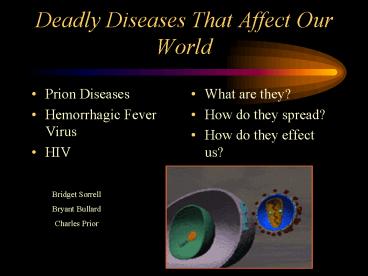Deadly Diseases That Affect Our World - PowerPoint PPT Presentation
1 / 13
Title:
Deadly Diseases That Affect Our World
Description:
Are transmissible from host to host of a single species and sometimes even from ... Bovine Spongiform Encephalopathy (BSE) or 'Mad Cow Disease' Kuru ... – PowerPoint PPT presentation
Number of Views:366
Avg rating:3.0/5.0
Title: Deadly Diseases That Affect Our World
1
Deadly Diseases That Affect Our World
- Prion Diseases
- Hemorrhagic Fever Virus
- HIV
- What are they?
- How do they spread?
- How do they effect us?
Bridget Sorrell Bryant Bullard Charles Prior
2
Prion Diseases
- Are transmissible from host to host of a single
species and sometimes even from one species to
another (such as a laboratory animal) - Destroy brain tissue giving it a spongy
appearance - For these reasons prion diseases are also called
transmissible spongiform encephalopathies or TSEs - Before the victim dies of a TSE, the damage to
the brain is reflected in such signs as loss of
coordination and - in humans - dementia.
3
What is the infectious agent in TSEs?
- One suggestion is that the disease is caused by
an infectious agent such as a virus. - But viruses have a genome and - despite intense
efforts - no evidence of a virus has ever been
found in these brain extracts. - To date, the evidence indicates that the
infectious agent in the TSEs is a protein.
4
Types of diseases and how they are transmitted
- Scrapie
- Bovine Spongiform Encephalopathy (BSE) or Mad
Cow Disease - Kuru
- Gerstmann-Sträussler-Scheinker disease (GSS)
- Fatal Familial Insomnia (FFI)
- Creutzfeldt-Jakob Disease (CJD)
5
Hemorrhagic Fever Viruses
- Some of the deadliest viruses in the world.
- Include Several Families of Viruses
- Flavivirus Yellow Fever
- Arenavirus Puumala
- Bunyavirus Guanarito
- Filovirus Ebola
6
Virus Transmission
- Carried by host animals which come into contact
with humans. - Monkeys
- Mice
- Mosquitoes
- Transmitted through human error.
- Unsterilized syringes in missionary hospitals
- Infected bodily fluids spread to those helping
dead or dying.
7
Virus Transmission
8
Effects on Humans
- Hemorrhagic Fever causes patience's to bleed to
death from the inside out.
- Example Ebola
- Destroys host cells directly.
- Attacks vital organs especially the liver.
- Decreases number of platelets in blood, reducing
its ability to clot. - Modify blood vessels in such a way that the
remaining platelets stick to them causing them to
rupture.
9
HIV The Immune System
- HIV replicates rapidly and destroys many cells of
immune system each day - Attack of HIV is met by a vigorous defense and
blocks HIV from multiplying out of control - Balance of power eventually shifts to HIV and
eventually causes AIDS
10
(No Transcript)
11
Evolutionary Theory of HIV in the Body
- On average, each time it replicates its RNA into
DNA it differs from the previous generation - HIV has a very high replication rate increasing
its chances of evolving a mutation that is
useful to the virus - After 10 years, the viral particles are several
thousand generations beyond the original particle
12
Treatment Options
- Those with weak immune systems control the virus
better - Vaccines are possible to boost immune system
against one particular epitope - Chemical agents should be applied early on in
treatment
13
Conclusions
- Currently these diseases have no known cure,
tough to detect, and treatment research is
ongoing.































